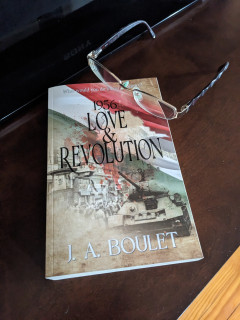History of the 1956 Hungarian Revolution

The Hungarian Revolution started many years before 1956. As with all political upheavals, it began with years of oppression and extremism. During the rule of Rákosi, Hungarians suffered greatly from years of war reparations, paying exorbitant taxes for the Stalin model of industrialization, and fell into a deep state of repression. The citizens were forced to pay almost two-thirds of their income to the government. They weren’t allowed to own property, except for the few agricultural co-operatives. All vehicles were state owned which meant most citizens didn’t have a car, only military personnel and politicians had this luxury.
Whatever money citizens saved on not owning a car was taken away from them in taxes and war fees. It was so extreme, in fact, that many families barely had enough money left to buy food. Hungarians instead did what they could with the cards they had been dealt, growing gardens and making vegetable stews and soups to survive. Interestingly enough, this is why many Hungarian women are impressive cooks. They had to be.
After Stalin’s death in March 1953, the Soviet Union had become heavily criticized for its brutal Stalin governance policies. A change was happening in Moscow and they wanted a new leader for Hungary, someone who could revive the stagnant economy.
Imre Nagy was the man Moscow needed to replace Rákosi. Unfortunately, the Soviet Union still had many Stalin supporters as well as reformists intent on change. An entire spy novel could be written just about this upheaval within the Soviet Union.
Imre Nagy was brought in and served as the Chairman of the Council of Ministers (de facto Prime Minister) of the Hungarian’s People’s Republic from July 4, 1953 to April 18, 1955. Rákosi, a stout Stalin supporter, was not pleased and was allowed to stay on, working in the background within the newly reformed Nagy government.
Under Nagy’s rule, a new system of compulsory delivery of produce was introduced, and opting out of the stifling agriculture co-operatives was also introduced. Nagy was a reformist but stayed within the sphere of Communism. His reforms provided much-needed reductions in food prices and he even reduced state control of media. Nagy encouraged debate on economic and political reform at universities and within his own cabinet. In August 1953, some political prisoners serving sentences of less than two years were also freed. It seems that Nagy was just what Hungary needed.
But it also seemed that Nagy took reform a bit too far for the old Stalin supporters. In January 1955, Imre Nagy was summoned to Moscow. He was heavily criticized for being too radical with his reforms and ordered to correct his errors. Rákosi, maliciously savouring Nagy’s mistakes, began exploiting the situation over the next several weeks and repeatedly accused Nagy of rightist deviation. Rákosi eventually won and Imre Nagy was dismissed as Prime Minister in April 1955.
Rákosi was reinstated as Prime Minister of Hungary in 1955. This political move angered Hungarians so much that they could no longer keep quiet. After having a taste of reform and economic recovery, Hungarians were once again plunged back in time to 1953. Rákosi repealed many of Nagy’s reforms and backtracked the entire country into his old trusted style of Stalin leadership. Hungarians were infuriated and Moscow was paying attention.
In February 1956, after losing his party membership, Imre Nagy listened to the secret speech from Nikita S. Khrushchev, the Soviet Union’s new leader in the Kremlin. Khrushchev delivered a scathing attack on Stalin at the 20th Communist Party Congress in Moscow, so severe, in fact, that several suicides and heart attacks followed the speech. Khrushchev denounced Stalin’s actions as plain murder and heavily criticized the ensuing personality cults.
Nagy refused to accept that he was stripped of his leadership and vowed to get it back. DISZ newspaper agreed with him and began printing newspapers every day instead of weekly, supporting a return to Nagy’s reforms. DISZ was a youth organization that met regularly at Budapest Technical University. They debated the future of Hungary on a political and economic basis, with little influence of student life.
Students at Budapest Technical University were the future hope of Hungary. Their parents had survived the brutality of WWII and the oppression of the aftermath. Students in 1956 were educated and highly regarded.
So, they took action.
Students and DISZ formed the Petőfi Circle and began holding regular debates on political reform. Szeged University and local workers also joined as members. The seeds of the revolution were always there, the students just began watering it.
The attendance at these meetings grew until one fateful day in October 1956 when two previous members of MEFESZ, a disbanded democratic student organization, showed up as guest speakers. MEFESZ was much different from DISZ because they supported radical democracy, not just communist reform. Their attendance at the meeting was a surprise to everyone because MEFESZ was dissolved by Communist Hungary in 1948 and all members had been jailed. DISZ tried to throw them out of the debate but the people wanted to hear what they had to say. Eventually, several DISZ members left the auditorium.
During that auspicious night, the Petőfi Circle members tabled 14 points of reform, later adding two more for a total of 16. Each one of the points directly addressed the political, social and economic concerns of the country. Not one point had anything to do with student life. Towards the end of the night, several students began chanting slogans, including one in particular, “Russians, go home!”
The next morning, on October 23, 1956, students agreed to join in the sympathy march for Polish workers at the statue of General Józef Bem. The General was a Polish hero in the Hungarian uprising of 1848-1849, and the crowd was pleasant and upbeat. Previous demonstrations were peaceful and enlightening, so students felt they had nothing to fear.
The crowd soon swelled to 200,000 citizens as the students handed out the 16 points of reform. They announced the points of reform to the crowd as someone began cutting the Soviet Union emblem out of the middle of the flag. This energized the protestors and they marched to parliament.
Political officials tried to speak to the crowd but it was beyond their hands now. The momentum of 200,000 frustrated and angered citizens had the power now.
The crowd split into several factions, one large group going to the Stalin statue at Dózsa György Road to personally carry out one of the 16 points. The eight-metre-high bronze statue was a symbol of the system and the demonstrators toppled it with torches and cut it into pieces for souvenirs.
Another group of demonstrators had arrived at the Radio building to broadcast the 16 demands of reform. Several AVH, the State Protection Authority, fired into the crowd, killing several students.
People began running in every direction, some fleeing and some forcing their way into the building in anger. The protestors were emotionally charged and furious now.
The Hungarian Army’s 8th Tank Regiment was called in to reinforce the defence of the Radio building. What happened next was truly the turning point of the revolution.
Hungarian Army soldiers were patriotic Hungarians, not Russians. They sympathized with the people. Several intense discussions with the demonstrators ensued until finally, the Hungarian Army joined the protestors. How many divisions joined the Revolution is unclear but what is clear is these soldiers were supporting their integrity and upholding their pledge to protect the people.
The Hungarian Army began fighting against the AVH and started distributing weapons and ammunition to the demonstrators. Several police stations also sided with the Hungarian people and a true armed insurgency began.
In the end, the Hungarians did win, but only for a brief few weeks.
But, more importantly, they won the hearts of the world. Although it came with a high cost.
The death toll was 3,000 Hungarians killed and 13,000 wounded. On the Soviet side, 722 were killed and 1,540 wounded.
A whopping 200,000 Hungarians were later forced to flee the country.
It is a sad but chilling story. The bravery of these citizens, wives, young boys, policemen and Hungarian soldiers is too much for words to properly convey. It is a poignant reminder that power truly is within the hands of the people.
